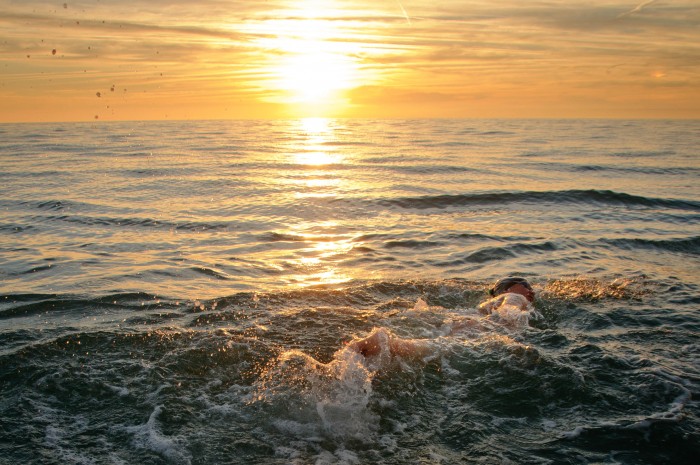Ladies we Love: Swimmer Chloë McCardel

In June, Australian marathon swimmer Chloë McCardel attempted to break a world record by swimming solo from Havana, Cuba, to Key West, Florida, a distance of 105 miles that would have taken her roughly 70 hours of swimming to complete. She set out without a shark cage or wetsuit in the shark and jellyfish-infested Florida Straits. After 11 hours of swimming, Chloë was forced to abandon the mission due to debilitating jellyfish stings. In the past, Chloë has completed six solo crossings of the English Channel (including the fastest female crossing in 2012), she’s won the 28-mile Manhattan Island Marathon and she’s set numerous other speed records. On top of all that, her swims help raise funds and awareness for cancer research, a disease that affected her mother when Chloë was a teenager. We reached Chloë on a rare down day at home in Australia.
WomensMovement: Some people might call you crazy to attempt to swim from Cuba to Florida. Why in the world did you settle on that particular mission?
Chloë McCardel: I like to joke that I am “professionally” crazy. I get called it enough that I’ve just adopted it. Although what I do isn’t exactly normal, it’s still an example of how much we can achieve when we set our mind to something, work really hard and have an incredible team around us. A single crossing of the English Channel is considered the swimming equivalent of climbing Mount Everest. After six crossings, I needed a fresh challenge. Since 1950, 21 people have tried and failed this swim without assistance, so this is the new Mount Everest of the 21st century.
WM: What scared you the most when you set out on this swim?
McCardel: The box jellyfish. They can be deadly. Our research had informed us they are in mass proportions during July and August, but not in June. We definitely dispelled that theory. Unfortunately, box jellyfish are still not that well understood even though there is a small group of international scientists working diligently in the area. They are amazing creatures. We can send a robot to land on Mars but we can’t find an antidote to or effectively track box jellyfish movements yet.
WM: What was going through your head when you realized you weren’t going to be able to complete the swim?
McCardel: I had box jellyfish coming at me from all angles underneath in the water once the sun had set on the first night, only 11 hours in. They aren’t design to attack humans or large animals and they were breaking apart upon contact, but the tentacles were still very effective at sticking to my skin and releasing toxins. After the first hit, there was an immense fireball of pain. Eventually, the pain was everywhere and it was so extreme I knew I needed to get out. I pulled a long tentacle out of my mouth while I was still in the water. I didn’t have the luxury of feeling disappointment, all I could think of was how much pain I was in and how much I wanted the pain to end.
WM: You’ve had so many major accomplishments throughout your swimming career, but can you pick the one thing you’re most proud of?
McCardel: The swim I am most proud of is my double solo crossing of the English Channel in 2012, which took 19 hours, 50 minutes. I actually made it one quarter of the way into the third crossing. That was the farthest any Australian has ever been. The air temperature dropped to 42 degrees Fahrenheit during the night and the water temperature was 59 degrees Fahrenheit—incredibly cold! I was quite hypothermic toward the end.
WM: How did you get into long-distance swimming?
McCardel: I swam competitively during secondary school. At university, I started triathlons and loved the open water swim. I ran a marathon and I also entered a swimming marathon. I enjoyed the swimming marathon much more—connecting with the marine environment and fighting through the water conditions. I won the race and wanted to keep seeing how far I could go, so I signed up to swim the English Channel.
WM: What is the most challenging aspect of what you do?
McCardel: Most people think it would be swim training up to 55 miles per week, the freezing cold water, swimming in pitch black, the monotony of swimming continuously for 20-plus hours or swimming in busy shipping lanes or with sharks or deadly jellyfish. But in reality the hardest aspect is the funding that is needed for the swim events. I don’t receive any government funding or assistance or any prize money. My husband and I fund most of our swims ourselves, which is supplemented by partnerships with some great companies and people who are kind enough to support me.
WM: And the most rewarding part?
McCardel: That’s easy! The amazing emails from children across the world who see my swims on TV. They send me photos and share their lives. They are usually doing swim lessons themselves. I also love when adults tell me that I have inspired them to go to a training session or get fit again. I am currently fundraising for cancer and someone with terminal cancer reached out to me and told me that what I did meant a lot to her, that I would dedicate my swim and charity fundraising to all those out there who fighting this disease.
Kamagra oral jelly Online something to buy the most convenient way. He doesn’t demand from you any actions except how to visit the website. And in separate with goods necessary to you to put the end. To specify your address and to wait for the supplier to whom you will give money.


LET'S GET SOCIAL